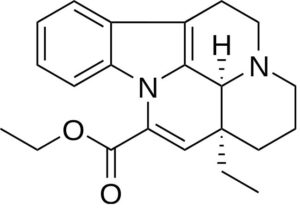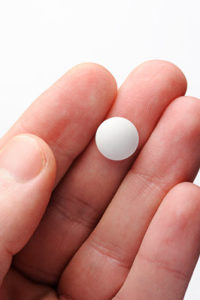Table of Contents
Vinpocetine (periwinkle extract, ethyl apovincaminate, Cavinton, Bravinton, Ceractin, Intelectol) is a semi-synthetic derivative of vincamine, an alkaloid derived from the lesser periwinkle plant (Vinca Minor L.).

Vinpocetine was first isolated from the periwinkle plant in 1975 by chemist Csaba Szántay. Hungarian pharmaceutical company Gedeon Richter began manufacturing Vinpocetine in 1978. Vinpocetine continues to be one of the company’s top selling drugs world-wide.[i]
Vinpocetine is used as a prescription drug in Japan, Europe, Mexico and Russia for the treatment of cognitive and cerebrovascular disorders. In the USA and Canada, Vinpocetine is sold as an OTC dietary supplement.
As a nootropic, Vinpocetine is used primarily to increase cerebral blood flow.
Other uses include using Vinpocetine for the prevention of motion sickness, menopause symptoms, chronic fatigue syndrome, seizure disorders, hearing and eye disorders, and even as a topical application to increase female sexual response.[ii]
Here we’ll investigate Vinpocetine’s value as a nootropic and to optimize cognition.
Vinpocetine helps:
- Cerebral Circulation. Vinpocetine helps boost blood flow to and within the brain. Improving the flow of oxygen and glucose that feed ATP to power brain cells. Improving alertness, cognition, concentration, memory and mood.
- Neuroprotectant. Vinpocetine blocks the accumulation of sodium in neurons, reduces the toxic effects of oxidative stress, inhibits the enzyme PDE1 and boosting blood flow, scavenges free radicals, and protects neurons from glutamate and NMDA toxicity.
- Neuroplasticity. Vinpocetine inhibits the enzyme PDE1 which can increase cAMP and cGMP. These cyclic nucleotides in turn activate a series of kinases that phosphorylate the transcription factors cAMP response element binding protein (CREB) and serum response factor (SRF), leading to the expression of plasticity-related genes.[iii] Boosting neuroplasticity enhances cognition and memory.
Overview
Vinpocetine (Cavinton, Intelectol) is a unique nootropic supplement derived from the lesser periwinkle plant (Vinca Minor).
A flowering plant native to central and southern Europe and Turkey, Vinca Minor is also grown as ground cover in the United States.

Since it was first released in 1978, Vinpocetine has earned a well-deserved reputation with the nootropics community for optimizing cognitive health. Primarily by boosting cerebral blood flow.
But to understand how and why Vinpocetine boosts cognition and protects your brain, we need to dive in to how blood flows in your brain.
An optimized adult brain gets about 1/7th of your heart’s output of blood every minute. Your brain needs this blood flow for a constant supply of glucose, oxygen and other nutrients to keep it functioning properly.
Unlike other organs and muscles in your body, your brain cannot stand an interruption in this steady flow of blood.
Two carotid arteries in the sides of your neck send blood to the front and top of your brain. Arteries in your vertebrae (spine) join with your carotid arteries at the base of your brain to form the Circle of Willis.[iv]
The Circle of Willis is critical because it is the only area of your body where all four major blood vessels join. Allowing blood to be sent to areas where it is needed. Even if one of the major blood vessels becomes blocked.
We’ll take a look at “How things go bad” later in this article. The good news is that Vinpocetine can have a profound effect on maintaining and repairing your brain’s blood vessels, cerebral blood flowing through the Circle of Willis, and to individual brain cells.
Vinpocetine not only helps increase cerebral blood flow, it also works as a powerful antioxidant and anti-inflammatory in your brain.
How does Vinpocetine work in the Brain?
Vinpocetine boosts brain health and function in several ways. But two in particular stand out.
- Vinpocetine boosts cerebral circulation. Your brain only accounts for about 2% of your bodyweight, but it consumes about 20% of the oxygen and nutrients circulating in your blood.[v] This is why strong, healthy cerebral blood flow is so critical to your brain health and cognitive performance.
Vinpocetine inhibits an enzyme called PDE1 (phosphodiesterase type 1) while reducing calcium levels in brain cells. When both of these are elevated, the smooth muscle in blood vessels contract, narrowing the diameter of blood vessels. And restricting blood flow to that area of the brain.
You may be familiar with PDE5 inhibitors like Viagra® which work to dilate blood vessels and maintain healthy blood flow to your penis. Vinpocetine has a similar mechanism of action in your brain.
In two separate clinical studies, chronic ischemic post-stroke patients were treated with either a single infusion, or daily infusion of Vinpocetine for 2 weeks.
Vinpocetine increased cerebral glucose uptake and glucose metabolism in both the stroke region of the patient’s brains as well as the intact brain tissue.
Patients in the 2-week long treatment also showed increased cerebral blood flow especially in the thalamus, basal ganglia and visual cortex regions of the brain.[vi]
- Vinpocetine is an anti-inflammatory. Vinpocetine prevents the upregulation of NFκB (nuclear factor kappa-light-chain-enhancer of activated B cells) by TNFα (tumor necrosis factor alpha).
This sounds a little complicated, but has serious implications in the development of Parkinson’s and Alzheimer’s Disease. Here’s how it works…
NFκB is a protein complex that controls transcription of DNA, cytokine production (signaling protein) and cell survival. TNFα is a signaling protein (cytokine) involved in inflammation produced by neurons. Vinpocetine inhibits this action.
Vinpocetine also reduces the TNFα-induced expression of the mRNA of pro-inflammatory molecules such as interleukin-1β, monocyte chemoattractant protein-1 (MCP-1), and vascular cell adhesion molecule-1 (VCAM-1).
Researchers have found that Vinpocetine prevents this inflammatory response at the cellular nucleus level. And this mechanism of action is independent of Vinpocetine’s action on PDE1.
This is a very big deal because TNFα contributes to the neuronal cell death found in Parkinson’s Disease. And there is growing evidence that the accumulation of amyloid-β protein leads to an upregulation of interleukins and TNFα that contributes to neurodegeneration leading to Alzheimer’s Disease.
Scientists are now working on trying to determine if Vinpocetine can reduce inflammation in the brain. And help protect the brain from developing Parkinson’s or Alzheimer’s.[vii]
How things go bad
Poor cerebral blood flow, inflammation and free radicals (oxidation) can damage your brain. And one of the ways this manifests is memory loss. Left unchecked, it can develop into serious neurodegenerative diseases like Alzheimer’s and Parkinson’s Disease.
↓ Cognitive function declines
↓ Inflammation kills brain cells from the inside
↓ Free radicals destroy neurons and synapses
↑ Anxiety, depression and moodiness increase
↓ Concentration and memory declines
Poor cerebral circulation causes a domino effect in the brain affecting many critical processes. Memory, cognition, and decision-making all suffer as a result.
Vinpocetine benefits
Vinpocetine is one of the most researched nootropics on the planet. It was introduced to clinical practice in Hungary in 1978 for the treatment of cerebrovascular (brain blood flow) disorders and related symptoms.
Since then Vinpocetine has become a “reference compound” in pharmacological research of cognitive deficits caused by hypoxia (oxygen deficiency), ischemia (inadequate blood supply) and research into cyclic nucleotides (cAMP and cGMP).
Vinpocetine’s mechanism of action in the brain includes:
- Increasing brain blood circulation and oxygen utilization
- Increased tolerance for hypoxia and ischemia
- Anticonvulsant activity
- Inhibiting the PDE1 enzyme
- Increasing the pliability of red blood cells
- Inhibiting the aggregation of platelets (blood clots)[viii]
Hundreds of studies in animals and humans have shown Vinpocetine can repair and reverse the effects of damage caused by strokes. Vinpocetine can prevent the inflammation and damage by free radicals that can lead to neurodegenerative diseases like Parkinson’s and Alzheimer’s.
Vinpocetine can improve glucose and oxygen supply to critical brain cells through increased blood flow. Improving cognition, concentration, mental agility, anxiety, depression and memory.
How does Vinpocetine feel?
You should be able to feel the effects of Vinpocetine within an hour of taking it.
Neurohackers report that Vinpocetine reduces brain fog and mental fatigue. Most experience improved focus, memory and even an improved sense of well-being.
Vinpocetine’s effect on short-, working- and long-term memory can be profound. Remembering names, numbers and life events becomes easier.
At work or in school, Vinpocetine can assist in learning and helping your brain commit it to memory. You should feel a significant difference in your ability to focus at work.
And like any nootropic, Vinpocetine is not going to turn back the clock 30 or 40 years. But it will help to keep your brain functioning more smoothly.
Vinpocetine Clinical Research
Vinpocetine Improves Memory
12 healthy female volunteers were treated with 40 mg Vinpocetine 3-times per day, or a placebo, for 2 days in this randomized double-blind crossover study.
On day 3 of the study, and one hour following morning dosage of Vinpocetine, the women completed a battery of psychological tests. The study found that those who used Vinpocetine had a significant improvement in memory when compared to placebo.[ix]
Vinpocetine Repairs Long-Term Potentiation
If you have been having problems with long-term memory lately, this study is for you.
Researchers produced a “medial septal lesion” on rats in the lab. The medial nuclei are an area of the brain composed of medium-size neurons. These neurons receive signals from different areas of your brain including your hippocampus.
A lesion cuts off communication with an important memory-formation area of your brain. The effect of a lesion in this study was on hippocampus function and the long-term potentiation pathway.
The scientists found that damage in this area of the brain negatively affects long-term potentiation. The rats were then given either physostigmine, piracetam, Vinpocetine or Hydergine one hour after the lesion. And once-a-day for 6 days after the operation.
The study found that all of the drugs used in this study produced complete restoration of long-term potentiation. And shows that Vinpocetine is one of the most effective and least expensive ways to restore long-term potentiation and long-term memory formation.[x]
Vinpocetine Enhances Cognitive Performance
A placebo-controlled, randomized double-blind trial was conducted at the University of Surrey with 203 dementia patients using Vinpocetine. Patients received either 10 mg of Vinpocetine 3-times per day, 20 mg of Vinpocetine 3-times per day or a placebo 3-times per day for 16 weeks.
The patients were assessed on cognitive performance and measure of quality of life, including depression. Both Vinpocetine groups experienced a significantly improved cognitive performance score compared to placebo.
The study concluded that Vinpocetine was useful in the management of patients with symptoms of dementia. And there was no statistical difference in cognitive scores with 10 mg or 20 mg of Vinpocetine.[xi]
Vinpocetine Dosage
Vinpocetine has a reputation among neurohackers and in clinical trials for safety at recommended doses.
The recommended dosage for Vinpocetine is 10 mg taken 3-times per day with food. Vinpocetine seems to be more effective when taken with a meal or high quality fat like coconut or olive oil.
You can safely dose up to 60 mg of Vinpocetine per day total. But clinical trials and user experience nearly always report that higher doses provide no added benefit.
Vinpocetine Side Effects
Vinpocetine is well-tolerated and safe for use by most people. But if you’re particularly sensitive to supplements and drugs, try a starting dose of 5 mg of Vinpocetine and see how your body reacts.
If you’re dealing with low blood pressure you should avoid using Vinpocetine. This nootropic affects blood flow not only in your brain, but through your entire system. If you take Vinpocetine and feel light-headed or dizzy it could be a sign your blood pressure is low.
Vinpocetine affects clotting factors in your blood. And may decrease red blood cell platelet aggregation. So if you are using blood thinners or high doses of aspirin you should avoid Vinpocetine.
Stop taking Vinpocetine at least 2 weeks before surgery because of its effect on blood thinning and flow.
The US FDA issued a warning June 2019 stating that women who are pregnant or intend on becoming pregnant should not use Vinpocetine. Because a recent animal study shows that Vinpocetine decreased fetal weight and increased the chances of a miscarriage.
Where to buy Vinpocetine
Vinpocetine usually comes in 5, 10 or 20 mg tablets.
Many countries around the world require a prescription to purchase Vinpocetine. In the USA, the FDA recently added Vinpocetine to its “Dietary Supplement Ingredient Advisory List“.
The FDA says this list, “is intended to quickly alert the public when the FDA identifies ingredients that do not appear to be lawfully included in products marketed as dietary supplements.”
In this instance, Vinpocetine was put on FDA’s list at the request of a major pharmaceutical company who intend to make and market it as a prescription drug. Which means you can no longer buy Vinpocetine from vendors such as Amazon or Bulk Supplements.
I use and recommend: Life Extension – Vinpocetine
Nootropics Expert Recommendation
Vinpocetine 10 mg 3-times per day
 We recommend using Vinpocetine as a nootropic supplement.
We recommend using Vinpocetine as a nootropic supplement.
Your body does not make Vinpocetine on its own. So you must take it as a supplement.
Vinpocetine easily crosses the blood-brain barrier and is available within an hour of taking it. Vinpocetine works more effectively if taken with food.
Vinpocetine is especially helpful for those suffering from brain fog and memory loss. Vinpocetine helps increase cerebral blood flow bringing more oxygen and nutrients to brain cells.
Vinpocetine is helpful for those dealing with stroke recovery. This nootropic helps restore blood flow to damaged areas of the brain affected by stroke. And helps prevent damage caused by the increase in free radicals typically released during stroke recovery.
Vinpocetine is also helpful for those suffering from Alzheimer’s. It has been shown to boost blood flow to areas of the brain affected by amyloid-β protein aggregation. Vinpocetine helps tame inflammation associated with the disease. And studies are now underway to determine if Vinpocetine can prevent Alzheimer’s from taking hold in the first place.
You can safely take up to 60 mg of Vinpocetine daily if needed. One dose first thing in the morning. One dose early afternoon. And the last dose in the evening.
And for memory, Vinpocetine is great to stack with most of the racetams. Neurohackers report good success stacking Vinpocetine with Gotu Kola.
I use and recommend: Life Extension – Vinpocetine









Join The Discussion - 173 comments
deepak sadhwani
November 8, 2018
i am going to use Vinpocetine it is very expensive as supplement on amazon i am from india and it is also available at medical in tablet i can easily afford it, it is known as neurovin , can it be used with may we use it fish oil ,brahmi(bacopa) , b complex and iodine supplement, and our dosage for vepocetine is around 10mg three times in day please give your suggestions i would be very glad
David Tomen
November 8, 2018
Deepak, Vinpocetine is used primarily to boost cerebral blood flow. So is a great compliment to any nootropic stack.
Peter
October 7, 2018
David,
I tried Vinpocetine a few years back – 10 mg tablet by Source Naturals. I didn’t notice any cognitive improvement but did get a mild headache. Any idea why and how I could counter this? Should I take anything else with it?
David Tomen
October 8, 2018
Peter, not sure why Vinpocetine would cause a headache. It seems to work better when taken with a healthy fat. Maybe you were getting a bit of a detox reaction? If you try it again and it does the same thing try cutting your dose in half. This is a powerful nootropic.
If that doesn’t’ solve the problem then use Pine Bark Extract for boosting cerebral circulation.
Yordan
October 7, 2018
Hi David. For how long can i use vinpocetine. Is 30 days/10mg day enough to kick in ? Or i can take it every day like AGPC, ALCAR or Huperzine a.
Also have another question.I take 690MG of DMAE which is about 255mg(at20%) of active compound.Should i take it together with a choline source or spaced ,eg. 150mg AGPC and 4 hours later 690mg of DMAE+1g ALCAR and 50mg caffeine. The reason i take DMAE is because it prevents acetylcholine breakdown like Huperzine A does.Correct me if i´m wrong.
Cheers,
Yordan
David Tomen
October 7, 2018
Yordan, you can use Vinpocetine 3-times per day for as long as you find it useful. I’ve been using it daily for years.
Please see dosage recommendations for Huperzine A because it should not used daily.
You can take DMAE with the rest of your stack and it’ll be fine.
Wim
August 23, 2018
Sorry David,
I was not sure if links where admitted.
I compared all 3 supplements with your text, Examine (with lots of links to studies )and webmd.
And that is the information text I found. (Copied exactly)
It gave me the impression that Vinpocentine does the same as Gingko (except MAOI) but with positive side effects instead of negative as Gingko.
Examine has lots more studies on Gingko then Vinpocentine, less studies can be less info but as it is also used as a subscription drug I supose the studies are sufficient for the claims.
(Next time I will include the links then)
David Tomen
August 23, 2018
Thanks Wim. I have found the research from Examine to be thorough. But would not consider WebMD an authority site and do not trust their content.
Wim
August 22, 2018
Thanks David,
I do understand now why Vinpocetine is your choice of the 3 supplements to increased blood flow to the brain, seems to have better side effects as the other 2 .
Side effects on “Auto-immune diseases”:
Maritime pine bark extract might cause the immune system to become more active.
Vinpocetine might weaken the immune system in some people.
Liver:
There is some concern that ginkgo leaf extract might increase the risk of liver and thyroid cancers.
Vinpocetine potency not significantly different than the comparator of 30mg/kg silymarin (Milk thistle
Breast cancer:
Gingko: An increase in breast cancer risk has been noted to barely pass statistical significance in an analysis of cancer development in elderly persons
Vinpocetine: has suppressive effects on breast cancer cells
GABA interaction?
“Vinpocetine appears to be a potent ligand for the peripheral, but not central, GABAA receptor at the benzodiazepine binding site.”
What are your thoughts of still taking them at the same day? Should GABA Mg be reduced if Vinpocetine enhanced it? Or do I understand this wrong.
Thanks
David Tomen
August 22, 2018
Wim, where are you getting this information? I need links to clinical studies are other science-backed, peer reviewed science to be able to assess and comment on this.
Lasse
August 2, 2018
Hi Tomen,
I have ADD since probably always.
The last few years I have archieved great progress with nootropics. I use on a daily basis , B-vitamin complex, NALT, ALCAR and Mitogen from AxonLabs. They all give me great benefits.
I wanted to improve even further and decided to pick up som Vinpocetine from Jarrows Formular. My experience is that there were some odd feelings of blood going through the brain and other places around the body. Sometimes I would even have fascial flushing and I noticed a slight pain on the left side around my stomach or intestines.
I am very drug sensitive usually but wanted to try 10mg instead of the 5mg I started with. That resulted in my heart pounding faster and feeling of going insane because of some high level activity going on the brain.
I reduced the dosage to 5mg but still have stomach/intestine pain and fascial flushing. Its not only that it is annoying I am worried to why this is happening – to what is it a respons.
I did notice the good effect also. Very high energy and clarity and bright thinking like in a very natural way. I believe could very much feel the increased transportation of energy to the brain.
Would you consider it wise to keep taking Vinpocetine?
Thanks alot.
David Tomen
August 2, 2018
Lasse, it sounds like Vinpocetine is not right for you and you should stop using it. I suggest trying Pine Bark Extract for boosting blood flow and see if that works better for you. (https://nootropicsexpert.com/pine-bark-extract-pycnogenol/)
Rob
April 1, 2018
Hi Tommen
In relation to the anti-dopaminergic effect in studies shown in the site of Examine.com, what do you personally think about this. Personally I took Gingko/Vinpocetine from Trunatures and was quite good and now I will like to just take Vinpocetine.
Thank You
David Tomen
April 2, 2018
Rob, both Gingko and Vinpocetine influence cerebral blood flow. But Gingko acts more like an MAOI. So it depends on what you are trying to achieve. I love Vinpocetine and use 10 mg 3-times per day.
Tammy
May 17, 2017
David,QUESTION: I just started taking Vinpocetine, and I can say I noticed a positive difference right away. I stopped and started twice all ready because by the second 10 mg dose I get a nasty metallic taste in my mouth. Do you think this side effect will go away? Thanks, Tammy
David Tomen
May 17, 2017
Tammy, first thing I’d suggest is trying another brand of Vinpocetine and see if that makes the metallic taste go away. Are you using any other medications? I’m not aware of any contraindications with prescription meds other that what I have in the Side Effects section of this post.
If you try another brand and that doesn’t solve the problem, try cutting your dose in half. In other words, try two 5 mg doses. Here’s a good reference from the Cleveland Clinic that may also give you some ideas on what to look out for:
https://health.clevelandclinic.org/2015/04/8-possible-causes-for-that-metallic-taste-in-your-mouth/
Tammy
May 17, 2017
David, Just wanted to say I love your site , I subscribed 3 years ago. The information you make available is very helpful. Here are my meds, I am taking (Adderall 20 mg 2 x a day), which has not been very useful because of building up a tolerance. Then I added the vinpocetine and it seem to help the adderall I probably could cut back to only 20 mg a day . I tried the vinpocetine without the (add med) but did not feel as focused as I did combining them. Also I take generic form of (zoloft 50 mg 1x a day). As far as other supplement, calcium. I also usually take Rhodiola Rosea but I ran out 2 week ago and have not reordered yet. Thanks for the link above but I all ready been to the possible cause of metallic taste in your mouth. I swear as soon as I stop taking the Vinpocetine it goes away. I will try your suggestion on cutting down to % mg a day. Thanks
David Tomen
May 17, 2017
Tammy, check that Cleveland Clinic article again. #3 mentions calcium supplements causing a metallic taste. Zoloft could be the other culprit as well. What brand of Vinpocetine are you using? One of the problems with dietary supplements is contamination with heavy metals. That’s why I’m concerned of the brand you’re using.
Also, it could be that Vinpocetine is bringing out the metallic taste symptoms in something else that you’re taking.
Did you see my post on ADHD here? https://nootropicsexpert.com/best-nootropics-for-adhd-add/. I had a big issue with tolerance too. I explain how I’ve managed to avoid tolerance in that post.
Tammy
May 17, 2017
Puritan’s Pride is the brand in vinpocetine. I have been using calcium for 10 years ,the same brand. I have been on Zoloft for 10 years , was on 200 mg a day ween down to 50 mg a day. That was rough, it took a year to get the zoloft down to 50 mg. Also I have been on add med for 10 years. I was diagnosed with Add when when I started back to school in my early 40’s . I have tried some of the things you have suggested with the tolerance, but I can not afford to take a stack like you are on. I could tolerate a stack if only 2 Nootropics were the case. I felt I have always had trouble with prescriptions, the way they react with me. I’m allergic to most penicillin and sulfur. If they need to use a local anesthesia like at the dentist or topical surgery that does not require complete sedation, the doctors can not be leave how much it takes to get me numb. Just about 2 months ago Dr. wanted me to try a prescription strength allergy medicine. I had to stop it after 4 days ,eyes swelled and itched more than normal. TO MY SURPRISE THE Vinpocetine seem to immediately re leave my allergy symptoms that is why I do not want to stop taking it. I tried another presciption allergy med and it made me very agitated, I could not even stand to be around myself. I sometimes wonder if I have a problem with the way my body absorbs medication and that is why my reactions are not good. I am taking the vinpocetine with fat. David I have tried the NADH 5 mg , made me feel funny, like not clear thinking. I did check out the ingredients in mind lab pro. You would think with all the nootropics that is in that would be all one would need. I have spent quiet a bit of money trying different things, thus far the Vinpocetine is the only thing I can honestly say I see a big difference in focus and staying alert and I feel a better since of well being. If you have anymore suggestions I am willing to listen. Thanks
David Tomen
May 17, 2017
Puritan’s Pride is made by the same company who makes Nature’s Bounty. And they thoroughly test their products so heavy metal contamination shouldn’t be an issue. Thank you for sharing your problems with most prescription meds. I have the same problem. If you could call it a problem. It’s likely more of a blessing in disguise.
And I completely understand budget issues when it comes to nootropics and supplements. My wife brings it up at least once a month. For tolerance with stimulants I’d concentrate on whatever can get your dopamine up and neuroreceptors repaired. So NALT is top of my list.
My only other suggestion is try Mind Lab Pro. It’s got 6 mg of Vinpocetine, Rhodiola Rosea and NALT. I really feel that is was Mind Lab Pro’s formula more than anything that helped me get completely off of Adderall for a year. But I’m truly Adult ADD and need the help of prescription stimulants. So I’m back on 20 mg. Ritalin twice a day.
Seriously considered consolidating your Rhodiola and Vinpocetine by trying Mind Lab Pro for a month. And see if it works for you.